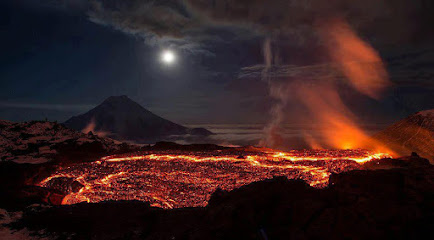Sage Gaudapada:~ The non-dual Atman is realized when the individual self (jiva) is awakened from its ignorance. Atman is unborn, dreamless, sleepless, and motionless and is beyond duality. It is cognition at its purest. It is Brahman- Ayam Atma Brahma, this Atma is that Brahma; Thus epitomizing the core of Upanishad teachings.
Sage Gaudapada expands further on these states of consciousness. The Self is AUM.
AUM represents the manifest and un-manifest aspects of Brahman. It is the single syllable that symbolizes and embodies Brahman, the Absolute Reality. It is the Pranava that pervades all existence and is our very life-breath.
Vaisvanara in the waking state is A the first part of AUM, One, who realizes this, attains his desires.
Teijasa in the dream state is U the second part of AUM. One, who realizes this, attains knowledge.
Prajna in deep sleep is M the third part of AUM, concluding the sounds of the earlier two parts. One, who realizes this, attains a compressive understanding of all.
The Syllable AUM in its entirety stands for the fourth state, Turiya the one beyond the phenomenal existence, supremely blissful and non-dual.
AUM in its integral whole stands for the fourth state which is transcendental, devoid of phenomenal existence, and is the source of all existence. AUM represents the Ultimate Reality.
AUM is thus verily the Self itself. One who realizes this merges into that Self. Meditate on AUM as the Self.
Remember:~
Sage Sankara ’says:~ "Kuruthe Ganga sahar gamanam Vratha paripal mathva dhanam. Gyana Vihine.Sarva Mathene.”
Gnana is common to all religions. There is nothing like One Gnana for a Hindu and another for a Christian.
The entire philosophy of Sage Sri, Sankara can be summed up in the following statement:-
Brahma satyam, jaganmithya, jivobrahmaivanaparah: - Brahman alone is real; the world is non-real and the individual Self is essentially not different from Brahman.
This is the quintessence of Sage Sankara’s Advaitic wisdom.
Remember:~
The consciousness is the one single reality or Brahman. The individual self is a reality within the duality. There is no individual in the realm of the nondual reality.
Sage Sankara says:~ One alone exists, and the rest is all superimposition on that One, due to ignorance.
Through a systematic inquiry into the nature of the mind, which is present in the form of the universe, one arrives at the position that the soul, the innermost self, which is present in the form of consciousness, is the ultimate truth or Brahman.
The Soul, the Self is constant and, therefore, real, while the phenomena constituting the universe are constantly changing and, therefore, unreal. The final conclusion is that the form, time, and space or the universe are one in essence. That essence is consciousness. Thus, no second thing exists other than consciousness.
The seeker of truth has to take into account all three states of our existence, which is waking, dream, and deep sleep ~ in waking or dream one experiences duality, and in deep sleep, there is only non-duality. To obtain a complete picture of our existential reality, we need to include evidence from all three states. This is the phenomenology of consciousness.
Remember:~
Consciousness is one only, without a second. One experiences the manifold universe ignorance ~ led illusion “covers" the One and "projects" the Many.
The illusion is the veil on consciousness. In truth, only One, non-dual Reality is all there is. Consciousness is all-pervasive. It is intrinsically Real, self-effulgent, infinite, undifferentiated Pure.
When the Soul, the Self, wakes up to its own formless nondual true nature, ignorance ceases, and the illusion, which is present in the form of duality never again experienced as reality.
The show of the illusory duality, however, continues, as before. Only our identification with a particular actor's role is gone forever because the self is in its own awareness.
Self-awareness is Brahmic Bliss! This state is already ours always in deep sleep in a "general" way. When the Self-Knowledge dawns then one is awake to it in a "special" way in the midst of duality.
Remember:~
Atman=Brahman or the Self, capture the essence of the immanent (Self) and the transcendent (Brahman) Reality. Humanity has not yet conceived a more lofty conception of its position in the universe.
Advaita only means the negation of duality. The Soul, which is present in the form of consciousness, is the ultimate truth or Brahman. Consciousness is the cause of the origin, maintenance, and withdrawal of the universe is Advaita (i.e. non-dual), which means that consciousness transcends all conceptions, positive and negative. Nothing positive can ever be imagined or said about it.
Consciousness is existence absolute, awareness absolute. Existence absolute means that consciousness is not unreal or non-existent. And it is not the unconsciousness. Nothing positive can be stated about consciousness.:~Santthosh Kumaar




